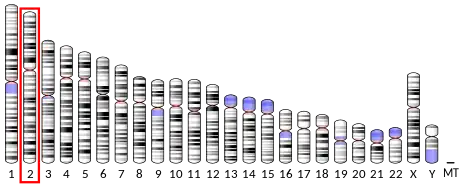OTX1
Homeobox protein OTX1 is a protein that in humans is encoded by the OTX1 gene.[5][6]
Function
This gene encodes a member of the bicoid sub-family of homeodomain-containing transcription factors. The encoded protein acts as a transcription factor and may play a role in brain and sensory organ development. The Otx gene is active in the region of the first gill arch, which is related to the upper and lower jaw and two of the bones of the ear.[7] A similar protein in mice is required for proper brain and sensory organ development and can cause epilepsy.[6]
References
- GRCh38: Ensembl release 89: ENSG00000115507 - Ensembl, May 2017
- GRCm38: Ensembl release 89: ENSMUSG00000005917 - Ensembl, May 2017
- "Human PubMed Reference:". National Center for Biotechnology Information, U.S. National Library of Medicine.
- "Mouse PubMed Reference:". National Center for Biotechnology Information, U.S. National Library of Medicine.
- Kastury K, Druck T, Huebner K, Barletta C, Acampora D, Simeone A, Faiella A, Boncinelli E (July 1994). "Chromosome locations of human EMX and OTX genes". Genomics. 22 (1): 41–5. doi:10.1006/geno.1994.1343. PMID 7959790.
- "Entrez Gene: OTX1 orthodenticle homeobox 1".
- Shubin, Neil "Your Inner Fish" 2009
Further reading
- Simeone A, Acampora D, Mallamaci A, Stornaiuolo A, D'Apice MR, Nigro V, Boncinelli E (July 1993). "A vertebrate gene related to orthodenticle contains a homeodomain of the bicoid class and demarcates anterior neuroectoderm in the gastrulating mouse embryo". The EMBO Journal. 12 (7): 2735–47. doi:10.1002/j.1460-2075.1993.tb05935.x. PMC 413524. PMID 8101484.
- Acampora D, Mazan S, Avantaggiato V, Barone P, Tuorto F, Lallemand Y, Brûlet P, Simeone A (October 1996). "Epilepsy and brain abnormalities in mice lacking the Otx1 gene". Nature Genetics. 14 (2): 218–22. doi:10.1038/ng1096-218. PMID 8841200. S2CID 32251856.
- Nagao T, Leuzinger S, Acampora D, Simeone A, Finkelstein R, Reichert H, Furukubo-Tokunaga K (March 1998). "Developmental rescue of Drosophila cephalic defects by the human Otx genes". Proceedings of the National Academy of Sciences of the United States of America. 95 (7): 3737–42. Bibcode:1998PNAS...95.3737N. doi:10.1073/pnas.95.7.3737. PMC 19906. PMID 9520436.
- Weimann JM, Zhang YA, Levin ME, Devine WP, Brûlet P, McConnell SK (December 1999). "Cortical neurons require Otx1 for the refinement of exuberant axonal projections to subcortical targets". Neuron. 24 (4): 819–31. doi:10.1016/S0896-6273(00)81030-2. PMID 10624946. S2CID 407402.
- Francks C, Fisher SE, Olson RK, Pennington BF, Smith SD, DeFries JC, Monaco AP (March 2002). "Fine mapping of the chromosome 2p12-16 dyslexia susceptibility locus: quantitative association analysis and positional candidate genes SEMA4F and OTX1". Psychiatric Genetics. 12 (1): 35–41. doi:10.1097/00041444-200203000-00005. hdl:11858/00-001M-0000-0012-C9C5-5. PMID 11901358. S2CID 15050388.
- Puelles E, Annino A, Tuorto F, Usiello A, Acampora D, Czerny T, Brodski C, Ang SL, Wurst W, Simeone A (May 2004). "Otx2 regulates the extent, identity and fate of neuronal progenitor domains in the ventral midbrain". Development. 131 (9): 2037–48. doi:10.1242/dev.01107. PMID 15105370.
- Rual JF, Venkatesan K, Hao T, Hirozane-Kishikawa T, Dricot A, Li N, Berriz GF, Gibbons FD, Dreze M, Ayivi-Guedehoussou N, Klitgord N, Simon C, Boxem M, Milstein S, Rosenberg J, Goldberg DS, Zhang LV, Wong SL, Franklin G, Li S, Albala JS, Lim J, Fraughton C, Llamosas E, Cevik S, Bex C, Lamesch P, Sikorski RS, Vandenhaute J, Zoghbi HY, Smolyar A, Bosak S, Sequerra R, Doucette-Stamm L, Cusick ME, Hill DE, Roth FP, Vidal M (October 2005). "Towards a proteome-scale map of the human protein-protein interaction network". Nature. 437 (7062): 1173–8. Bibcode:2005Natur.437.1173R. doi:10.1038/nature04209. PMID 16189514. S2CID 4427026.
External links
- OTX1+protein,+human at the U.S. National Library of Medicine Medical Subject Headings (MeSH)
This article incorporates text from the United States National Library of Medicine, which is in the public domain.
This article is issued from Wikipedia. The text is licensed under Creative Commons - Attribution - Sharealike. Additional terms may apply for the media files.



